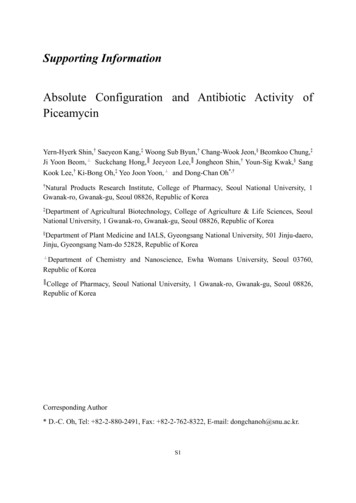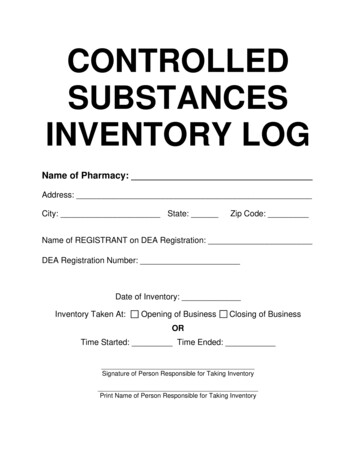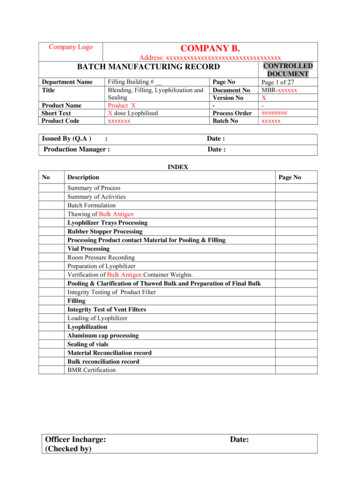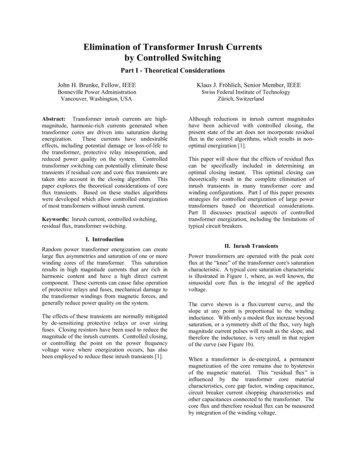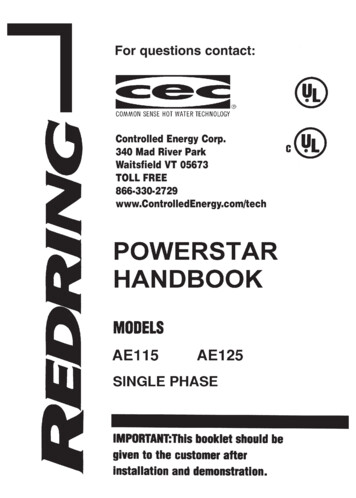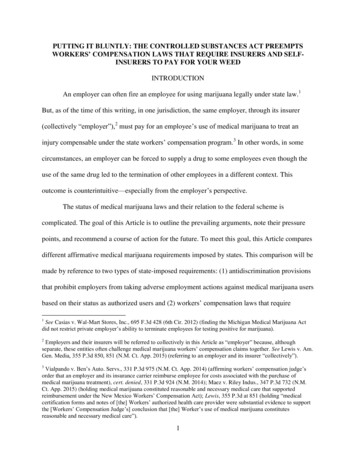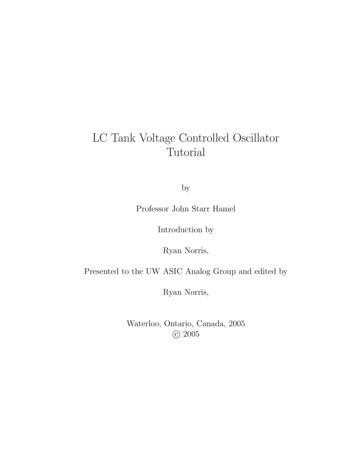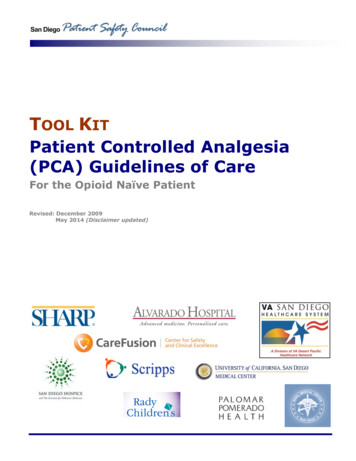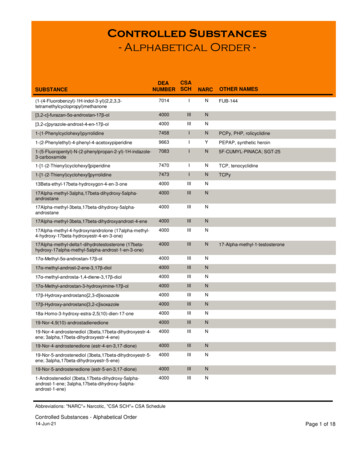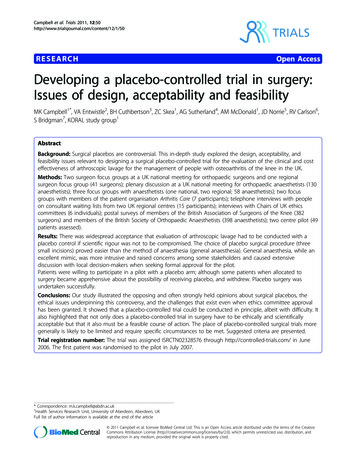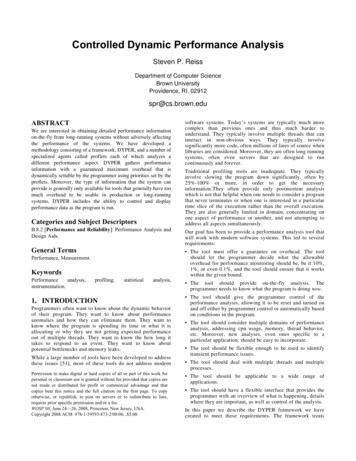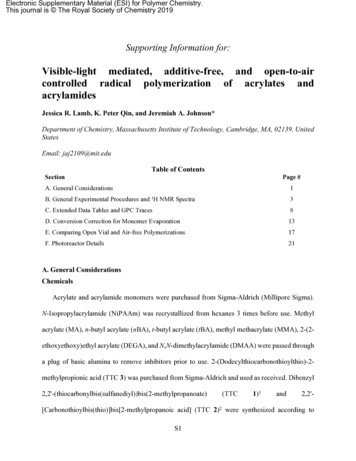
Transcription
Electronic Supplementary Material (ESI) for Polymer Chemistry.This journal is The Royal Society of Chemistry 2019Supporting Information for:Visible-light mediated, additive-free, and open-to-aircontrolled radical polymerization of acrylates andacrylamidesJessica R. Lamb, K. Peter Qin, and Jeremiah A. Johnson*Department of Chemistry, Massachusetts Institute of Technology, Cambridge, MA, 02139, UnitedStatesEmail: jaj2109@mit.eduTable of ContentsSectionPage #A. General Considerations1B. General Experimental Procedures and 1H NMR Spectra3C. Extended Data Tables and GPC Traces8D. Conversion Correction for Monomer Evaporation13E. Comparing Open Vial and Air-free Polymerizations17F. Photoreactor Details21A. General ConsiderationsChemicalsAcrylate and acrylamide monomers were purchased from Sigma-Aldrich (Millipore Sigma).N-Isopropylacrylamide (NiPAAm) was recrystallized from hexanes 3 times before use. Methylacrylate (MA), n-butyl acrylate (nBA), t-butyl acrylate (tBA), methyl methacrylate (MMA), 2-(2ethoxyethoxy)ethyl acrylate (DEGA), and N,N-dimethylacrylamide (DMAA) were passed througha plug of basic alumina to remove inhibitors prior to use. 2-(Dodecylthiocarbonothioylthio)-2methylpropionic acid (TTC 3) was purchased from Sigma-Aldrich and used as received. (thio)]bis[2-methylpropanoic acid] (TTC 2)2 were synthesized according toS1
literature procedures. Solvents were at least reagent grade, purchased from Sigma-Aldrich, andused as received.Methods and InstrumentationGel permeation chromatography (GPC) measurements for polymers soluble in N,Ndimethylformamide (DMF) were performed on an Agilent 1260 LC system with two Shodex KD806M GPC columns in series at 60 C and a flow rate of 1 ml/min with 0.025 M LiBr in DMF asthe eluent. A T-rEX refractive index detector (Wyatt) and a DAWN EOS 18 angle light scattering(MALS) detector (Wyatt) were used for polymer analysis. Respective dn/dC values were obtainedby injection of known concentrations of polymer samples. At least four samples were used perpolymer. Values are listed in Table S1. Molar masses were measured by static light scattering andcompared to Mn values obtained by 1H NMR spectroscopy. Poly(acrylamide) was not soluble inDMF and thus GPC measurements were obtained on an Agilent 1260 Infinity Series with threeAgilent Aquagel-OH Mixed-H columns in series using 0.02 wt% NaN3 in water as the eluent at 1ml/min. A T-rEX refractive index detector (Wyatt) and a DAWN 8 detector (Wyatt) were usedfor molecular weight analysis. The dn/dC of poly(acrylamide) was estimated using 100% massrecovery method. For both methods, all samples were filtered through 0.2 μm, 13 mm PTFEsyringe filters before injection.Table S1. Measured dn/dC valules (in mL/g) for polymers soluble in DMFpolymer samplepoly(methyl acrylate)poly(n-butyl acrylate)poly(t-butyl acrylate)poly(2-(2-ethoxyethoxy)ethyl acrylate)dn/dC0.04420.03410.02850.0484polymer samplepoly(methyl methacrylate)poly(N,N-dimethyl acrylamide)poly(N-isopropyl acrylamide)dn/dC0.05400.08310.0714Preparatory GPC (PrepGPC) was performed on a JAI Preparative Recycling GPC equippedwith two sets of JAIGEL columns: (1) 2.5HR column and 2H column (20 mm ID x 600 mm length)in series and (2) 2.5H column and 2H column (40 mm ED x 600 mm length) in series. ChloroformS2
was used as the eluent. The samples were monitored by both refractive index and UV (200–800nm) detection. 1H NMR spectra were recorded on Bruker Avance DRX 400 or 600 MHz NMRspectrometers at 22 C. Signals are reported in δ units, parts per million (ppm), and were measuredrelative to residual solvent peak (CDCl3: 7.26 ppm, D2O: 4.79 ppm). Deuterated chloroform andD2O were purchased from Cambridge Isotope Laboratories.Matrix-assisted laser desorption/ionization time-of-flight (MALDI-TOF) spectra wereobtained with a Bruker Omniflex MALDI-TOF operating in positive linear mode. idene]malononitrile (DCTB, purchased from Sigma) wasused as the matrix and sodium trifluoroacetic acid (purchased from Sigma) was used as thecationisation agent. Separate stock solutions (20 mg/ml) of analyte, matrix, and cationisation agentwere made in THF then mixed in a volume ratio of 2:10:1. The solution was spotted onto a steeltarget plate and the solvent was allowed to evaporate prior to analysis. FlexAnalysis (Bruker) wasused to analyze the data. Ultraviolet-visible (UV-vis) spectra were obtained on either an AgilentCary 4000 UV-vis Spectrophotometer or an Implen NP80 NanoPhotometer in Wavescan mode.See Section F for full details on the photoreactor setup.B. General Experimental Procedures and 1H NMR SpectraOpen vial photopolymerizationA stock solution was made with TTC (1, 78.9 mg, 0.170 mmol), monomer (MA: 3.1 ml, 3.043g, 35.35 mmol), and DMSO (3.1 ml) (scale of the stock solution varied). A pipettor was used totransfer 0.5 ml of the stock solution into a 1 dram glass vial that was subsequently kept closed untilthe start of the reaction to prevent monomer evaporation. The vial was placed in the 1 dram vialholder atop a custom-built photoreactor (see Section F) that was actively being cooled by a dryice-acetone bath inside of a ventilated flammable cabinet. After the vial cap was removed, theS3
reaction was irradiated with 450 nm light (power setting 5). Each reaction was irradiated by asingle LED and the vial sat directly on top of the lens to maximize light intensity. (Note: Due tothe high light intensities, Kentek KBS-5301 blue-blocking laser safety glasses were wornwhenever the photoreactor was in operation.) Additional dry ice was added to the bath every 20–30 minutes to maintain cooling. After 60 minutes of irradiation, the light was shut off and the vialwas quickly capped, covered in aluminum foil, and cooled by dry ice to ensure the reaction stoppedright away. Aliquots were analyzed directly by 1H NMR spectroscopy and gel permeationchromatography. Poly(MA) was purified by dissolving in DCM and precipitating into coldhexanes 3x or by prepGPC to form a yellow sticky solid.Representative 1H NMR spectraOOOSOSOOOSOFigure S1. 1H NMR (CDCl3, 400 MHz) of poly(methyl acrylate) purified by prepGPC, sample from Table S3, entry 9.S4
OOOSSOOOSOOFigure S2. 1H NMR (CDCl3, 400 MHz) of poly(n-butyl acrylate) purified by dialysis against DCM, Table 2, entry 1. Note:resonances from 5.5 – 6.5 ppm correspond to unreacted monomer.OOtBuOOSSOtBuOOSOFigure S3. 1H NMR (CDCl3, 600 MHz) of poly(tert-butyl acrylate) precipitated into MeOH/H2O 1:1 Table 2, entry 3.S5
22OOOOSOSOOOOSOFigure S4. 1H NMR (CDCl3, 400 MHz) of poly(2-(2-ethoxyethoxy)ethyl acrylate) purified by prepGPC, Table 2, entry 5.Chain extension of poly(MA)A 1 dram glass vial was charged with precipitated poly(MA) (200–300 mg) and dissolved in a1:1 solution of monomer:DMSO (0.5 ml for MA, 0.6 ml for tBA). The vial was placed in the 1dram vial holder atop a custom-built photoreactor (see Section F) that was actively being cooledby a dry ice-acetone bath inside of a ventilated flammable cabinet. After the vial cap was removed,the reaction was irradiated with a single 450 nm LED (power setting 5). (Note: Due to the highlight intensities, Kentek KBS-5301 blue-blocking laser safety glasses were worn whenever thephotoreactor was in operation.) Additional dry ice was added to the bath every 20–30 minutes tomaintain cooling. After 60 minutes of irradiation, the light was shut off and the vial was quicklyS6
capped, covered in aluminum foil, and cooled by dry ice to ensure the reaction stopped right away.Aliquots were analyzed directly by 1H NMR spectroscopy and gel permeation chromatography.Deprotection of poly(tert-butyl acrylate) to polyacrylic acidOn the basis of the procedure published by Oshima and coworkers,3 poly(tBA) (9.8 mg) wasmeasured out in a 1 dram vial. 750 μl of a trifluoroacetic acid/DCM solution (TFA:DCM 1:4) wasadded to the vial before placing on an orbital shaker at 130 rpm for 24 hours. The supernatant wasremoved and 1 ml DI water was added before putting back on the orbital shaker for 18 hours.Samples were centrifuged before the liquid was removed and the white powder (3.2 mg) was driedin vacuo. The drastically altered solubility properties and the 1H NMR spectrum (Figure S5compared to Figure S3) indicated that the deprotection was successful. The π to π* transitionof the TTC can be observed in the UV-vis spectrum of the resulting product (Figure S6).S7
H2O/HDOOOOH OSSOHOSOOFigure S5. 1H NMR (D2O, 400 MHz) of poly(acrylic acid).Figure S6. UV-vis spectra of ptBA and poly(acrylic acid) before and after deprotection, respectively.C. Extended Data Tables and GPC TracesDue to the reactions being performed in an uncapped vial and the volatility of methyl acrylate,monomer evaporation is inevitable. Control experiments were done to correct for conversion underthe optimized conditions for comparison to the air-free reaction (see Section D). However, for theoptimization, the listed conversions are not corrected for monomer evaporation since the amountof monomer loss will change with solvent, scale, concentration, etc. Therefore, Mn,theo is notS8
reported for Table S2 or Table S3. The experimental monomer:initiator (Actual MA:TTC) ratio islisted to give an idea of the differences between batches of stock solution.Table S2. Extended Table 1 detailing the polymerization optimization123λ(nm)625530450MA:DMSO(v/v, alMA:TTC191:1191:1191:1conv.(%)c 1 1199:1217:1 1 1 114 6:1206:1 0.537960204:1 1–––28450250:250DMSO0.523360204:1 1–––29450250:250DMSO0.511460204:1 1–––aConditions: MA:TTC (200:1), uncapped 1 dram vial, bottom irradiation, no stirring (see Section F for more details on the experimental setup).bIntegrated irradiance of the LED, see Section F for details on the measurement of these values. cConversion is uncorrected for monomerevaporation. dTTC 2 used. eTTC 3 used.S9
Normalized RUI (au)1314Retention15time (min)1617Figure S7. GPC trance for sample from initial discovery of the photocatalyst-free open vial polymerization.Normalized RUI (au)MA:DMSO 500:0MA:DMSO 400:100MA:DMSO 325:175MA:DMSO 250:250MA:DMSO 175:325MA:DMSO 100:400RetentionTime15(min)13 13.514 14.515.5 16 16.5 17 17.5 18Normalized RI (au)Figure S8. GPC traces for samples from concentration screen (Table S2, entries 4–9).200 ul300 ul400 ul500 ul600 ul13 13.5 14 14.5 15 15.5 16 16.5 17 17.5 18Retention Time (min)Figure S9. GPC traces for samples from scale screen (Table S2, entries 18–22).S10
Figure S10. (A) Plot of Mn versus light intensity for methyl acrylate (Table S2, entries 25–29), n-butyl acrylate, and N,Ndimethylacrylamaide. (B) Tabulated GPC data for n-butyl acrylate, and N,N-dimethylacrylamide.Table S3. Varying MA:TTC ratio to control molecular :11209516.3223.09d9 d313:1608423.0925.161.09aConditions: MA:DMSO (1:1, v/v), 0.5 ml scale, open 1 dram vial, bottomirradiation, no stirring. bConversion uncorrected for monomer evaporation.cBimodal molar mass distribution. dRun at 0.7 ml scale.Normalized RUI ion Time e S11. GPC traces of samples for reactions with different MA:TTC ratios (Table S3, entries 1–6).S11
Figure S12. GPC traces of poly(tert-butyl acrylate) samples with different tBA:TTC ratios from Table 2, entries 2–4.Normalized RUI (au)Figure S13. GPC traces of other acrylate and acrylamide monomers in DMF from Table 2, entries 1 and 5–8.2025 Retention30 Time35(min) 4045Figure S14. GPC trace of poly(acrylamide) in water with 0.02 wt % NaN3 from Table 2, entry 9.S12
Figure S15. GPC traces and tabulated data for experiments adding more monomer (MA:DMSO 1:1) after 1 hour of irradiationfollowed by an additional hour of exposure.Table S4. Control ExperimentsentryChange from standard /mol)Mn,GPC(kg/mol)Mw,GPC(kg/mol)Mw/Mn1No light, heat to 40 C0.5200:1 1n/a–––2No light, heat to 60 C0.5200:1 1n/a–––3No light, heat to 80 C0.5200:1 1n/a–––4No TTC0.5n/a 2n/a–––5stirring0.5205:1 1n/a–––620 ml vial2.0195:177n/a15.0917.501.167None. For comparison0.5198:15810.1515.9017.971.138Closed vial with vent needle0.5198:17312.7817.8919.951.129Closed vial (not degassed)0.5198:17813.6617.7719.511.1010Balloon of air0.5198:1111.933.584.831.35aStandard conditions: MA:TTC (200:1), MA:DMSO (1:1, v/v), uncapped 1 dram vial, bottom irradiation, no stirring.bConversion not corrected for monomer evaporat
DMF and thus GPC measurements were obtained on an Agilent 1260 Infinity Series with three . reaction was irradiated with 450 nm light (power setting 5). Each reaction was irradiated by a single LED and the vial sat directly on top of the lens to maximize light intensity. (Note: Due to the high light intensities, Kentek KBS-5301 blue-blocking laser safety glasses were worn whenever the .
